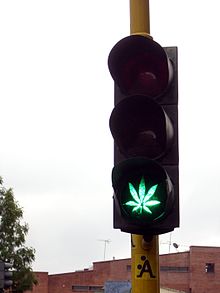
Cannabis in Colombia is fully legal for medicinal purposes (since 2016) and for industrial purposes (since 2021).
Cannabis for recreational purposes is partially legal: self-cultivation, possession and consumption have been legal (since 1994), but commercialization is illegal.
History
[edit]
Cannabis has been cultivated in Colombia since the late colonial period, when hemp was grown for its industrial fibres. However even at that early state, cannabis was recognized for its psychoactive uses, but these remained largely confined to the fringes of Colombian society, and discouraged by the Catholic church and national law.[1] By the 1920s, possibly spurred by wider cannabis use in the Caribbean, recreational use of cannabis emerged in the Atlantic ports, particularly Barranquilla, leading the Colombian government to further restrict cannabis in 1939 and 1946.[2]
In the 1960s and 1970s, North American cannabis traffickers made inroads into Colombia, leading to booming production in the Sierra Nevada de Santa Marta and the Urabá peninsula, where cannabis was smuggled in the region's massive northward shipments of bananas.[1]
According to the academic Steven Bender, marijuana from Colombia is known as "Colombian", as referenced in the American rock duo Steely Dan's 1980 song "Hey Nineteen".[3]
Decriminalization
[edit]In 1994 the Constitutional Court of Colombia ruled that possession of cannabis and other drugs in amounts for personal use was legal.[4] In 2012 the Colombian government officially decriminalized the possession of up to 20 grams of cannabis.[5] In 2015 the Colombian Supreme Court ruled that cultivation of up to 20 cannabis plants was allowed.[6]
Medical cannabis
[edit]In 2015, president Juan Manuel Santos signed legislation allowing cannabis and derivatives for medical uses, and establishing guidelines for dispensaries.[7]
References
[edit]- ^ a b James D. Henderson (10 February 2015). Colombia's Narcotics Nightmare: How the Drug Trade Destroyed Peace. McFarland. pp. 27–. ISBN 978-0-7864-7917-7.
- ^ Gabriel G. Nahas; Kenneth M. Sutin; David J. Harvey; Stig Agurell (5 April 1999). Marihuana and Medicine. Springer Science & Business Media. pp. 640–. ISBN 978-1-59259-710-9.
- ^ Bender, Steven (2008). The Significance of Spanish in English-only Times. Floricanto Press. p. 109. ISBN 9781888205084.
- ^ Treaster, Joseph B. (7 May 1994). "Use of Drugs Is Legalized By Colombia". The New York Times. Retrieved 28 July 2018.
- ^ "Colombia decriminalizes cocaine, marijuana | Public Radio International". Pri.org. 2012-06-30. Retrieved 2016-11-26.
- ^ Alsema, Adriaan (12 August 2015). "Colombia decriminalizes marijuana cultivation up to 20 plants". Colombia Reports. Retrieved 28 July 2018.
- ^ Paula Carrillo (2015-12-22). "Colombia legalizes medical marijuana". Yahoo.com. Archived from the original on 2016-11-18. Retrieved 2016-11-18.